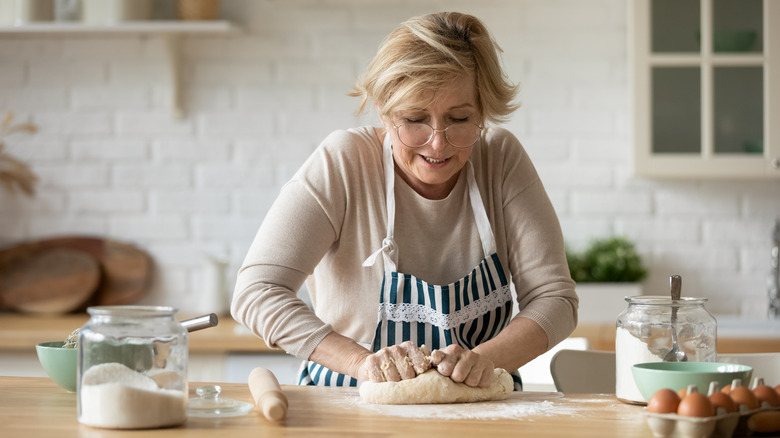Why You Should Use A Stand Mixer To Knead Dough
If you didn't before the pandemic, chances are you have made bread since. Whether sourdough, white bread, wheat, or pizza dough, making homemade bread is worth the effort. With a few humble ingredients and a little patience, you can have hot bread on the table demanding to be smothered in butter in a couple of hours — even less if it's pizza night.
But dough can be temperamental, responding to its surroundings and climate, making it necessary to adapt the recipe each time you make it. A common error bakers make is how they measure flour, according to The Food Network. The popular scoop and level technique can pack the flour, adding too much to our recipes resulting in a dry, dense product. The best method is to use a kitchen scale to measure the flour by weight. If you don't have one, you can still measure more accurately by adding some air into your flour container with a whisk, then use a spoon to fill up the measuring cup before leveling that off.
Once everything is accurately measured, it's time to knead the dough. Kneading is critical to achieving that chewy texture you want when making bread, pizza, bagels, etc. Kneading develops the gluten in the flour and helps add air into the dough, achieving the best texture. Sure, you can knead the old-fashioned way by hand, but if you have a stand mixer, it's time to break it out.
Use a dough hook if you have one
Evidence from archaeologists suggests people have been making bread for nearly 14,000 years, according to NPR, but only in the last few hundred years have mechanical kneading options arisen. Kneading by hand requires some muscle, knowledge of the technique, and as much as 25 minutes to spare, according to America's Test Kitchen. This step can also be messy and often results in adding too much flour to your dough. America's Test Kitchen recommends using a stand mixer with a dough hook instead of kneading by hand. Using a mixer can prevent you from using too much flour and save you time and labor.
When using a stand mixer, look for the dough to be uniform, elastic, and pull away from the sides of the bowl. If the dough still wet and clinging to the sides of the bowl after you've kneaded it for the desired amount of time, you should add a tablespoon of flour, then mix for a few more minutes. Continue this until you get the desired consistency. Conversely, if the dough becomes crumbly you can add a tablespoon of water to hydrate it. With all these tips and hacks you have no excuse — let's make that homemade bread tomorrow.

